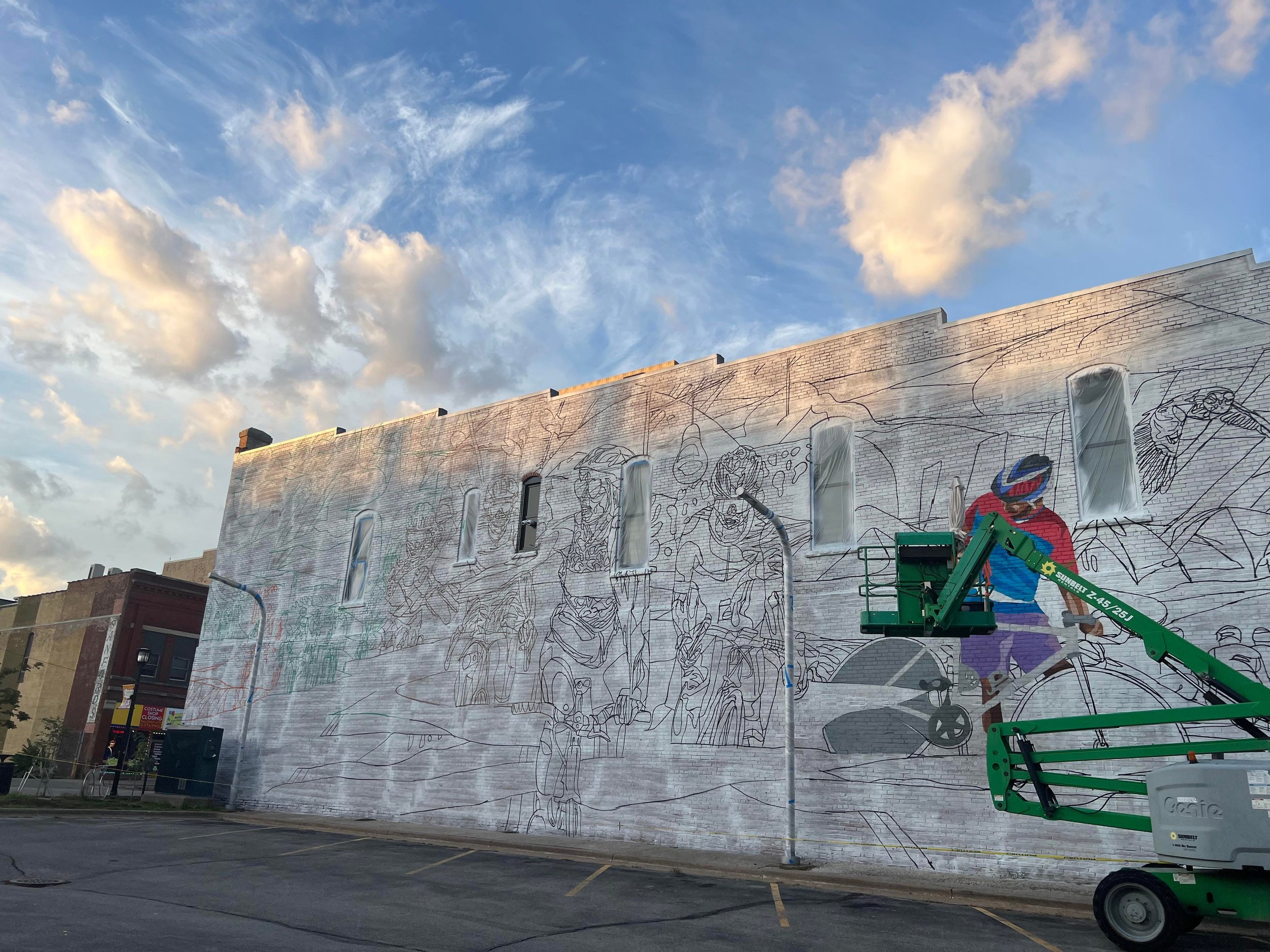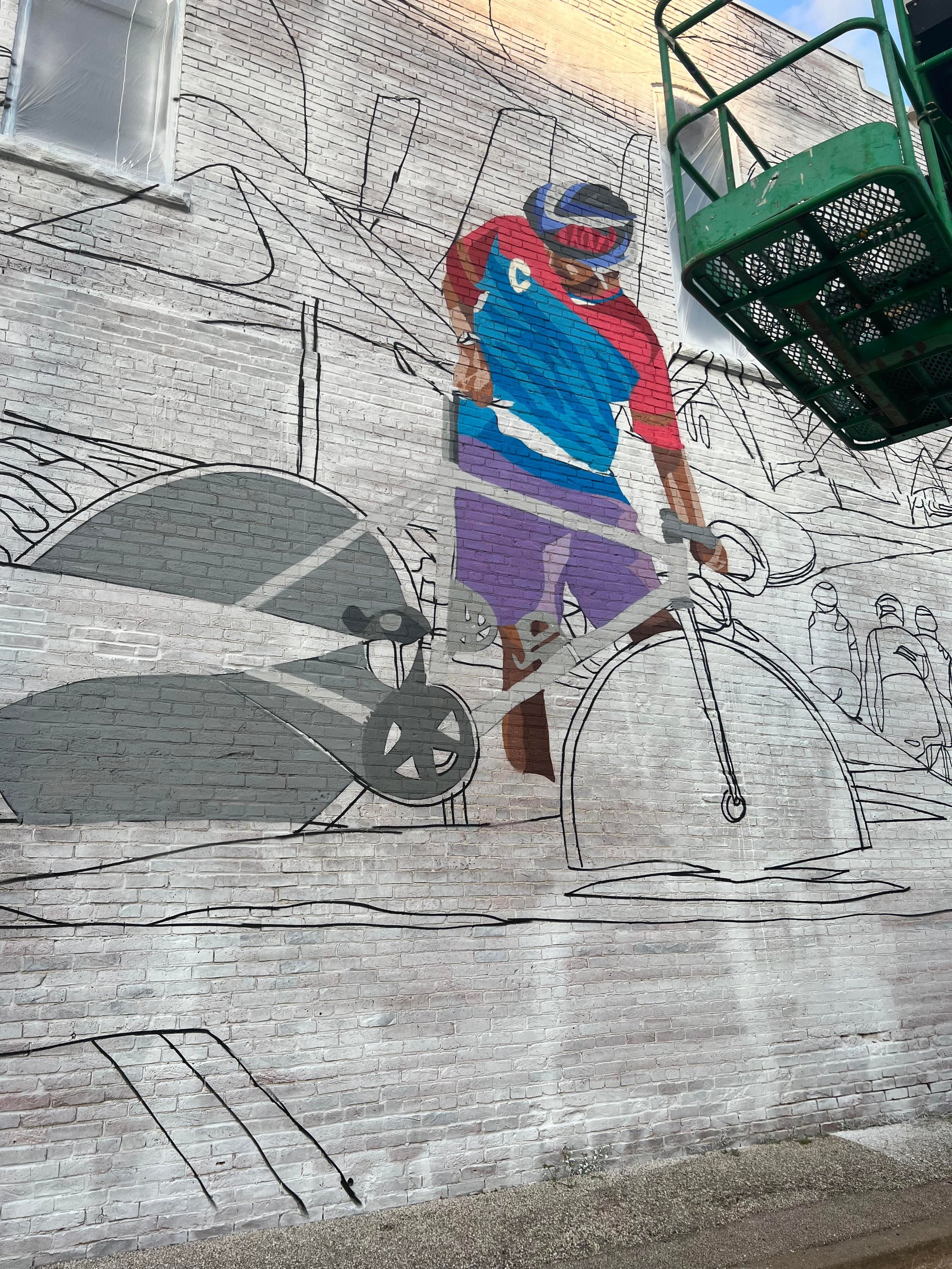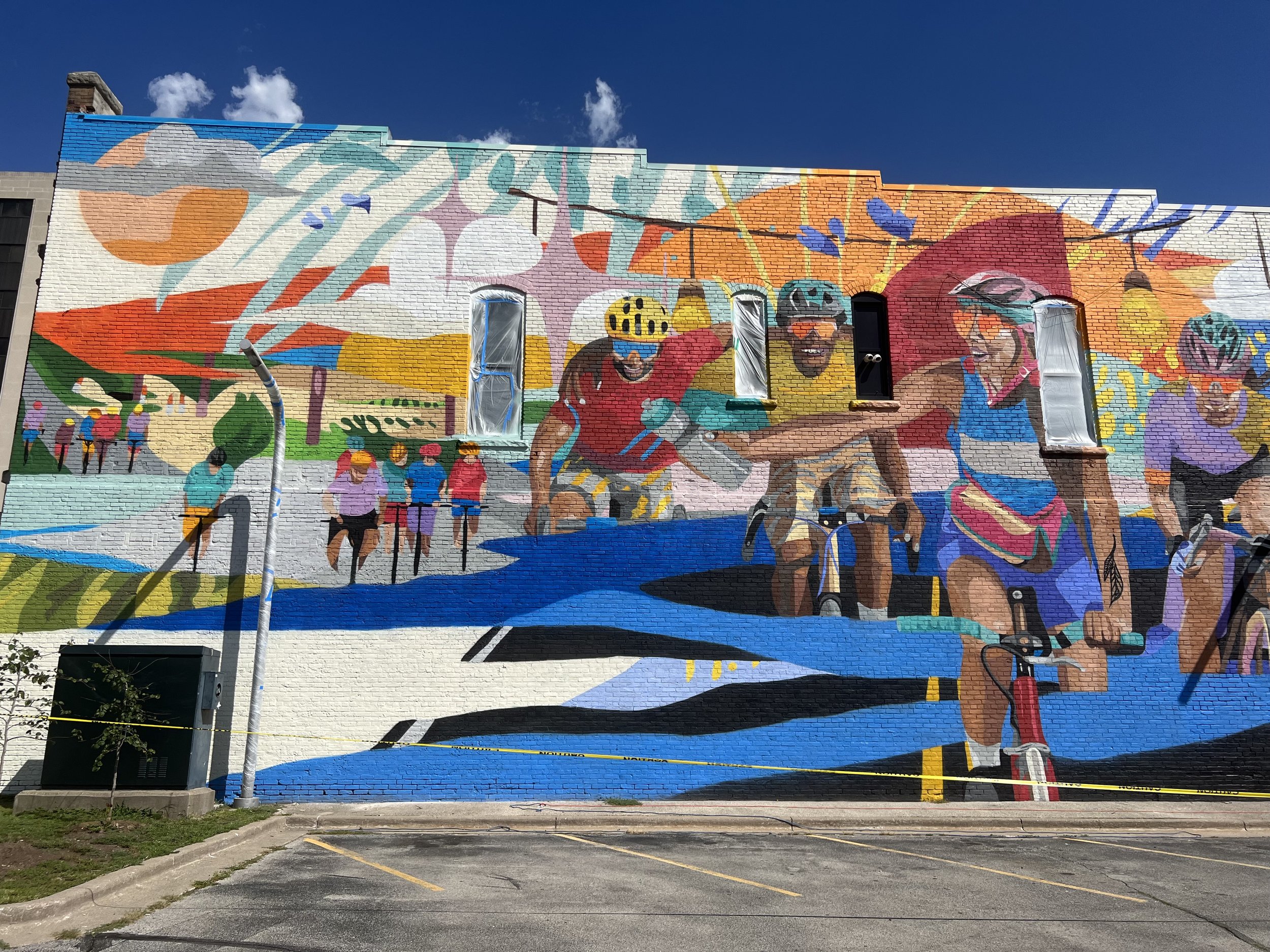Cera x On view gallery
Q&A with CERa
Q) You started your career out with wheat paste murals, how did you originally get involved with that technique?
A) I started doing wheatpastes in kind of a roundabout way. When my family moved to Milwaukee around age 11, my brother used to take me to local train tracks on our bikes to see all the amazing graffiti that people had been making. I think those images burned into my mind, all these fresh colors on a gritty and industrial space, the contrast stuck with me a long time. Combine this with spending almost all my youth skateboarding, I found tons and tons of interest in what our architectural landscape had to offer. Eventually I took basic art courses in high school, and I got really bored with blank pages and blank surfaces. My brother must have noticed something because he sent me a few books while he was going to college, all about graffiti and street art, and images of artworks made in both US and Europe. Something about those books opened a floodgate, because I don’t remember an exact day of learning how to create stencils, but all of the sudden I wasn’t just drawing pictures, I was focusing on deconstructing images layer by layer, and reassembling them on all sorts of surfaces like shirts and skateboards. I loved, and still do, that these images can take shape on so many different surfaces.
Fast forward a few years, I ended up attending Milwaukee Institute of Art and Design with a focus in Graphic Design. My thought was that it seemed a more promising career choice than fine arts and might give me an opportunity to work within the skate community later on. I got cagey within the first year and switched over to printmaking, because while I was doing my best to stay on top of assignments, all my free time was spent cutting stencils and playing with spray paint. This path was definitely the best call, I learned all about traditional printmaking techniques like screen printing, block printing, stone lithography, plate lithography, etching, etc. I leaned towards block printing as I really enjoyed the stark nature of black and white, and loved the labor of cutting them. I would practice these prints again and again on sticker paper and newsprint paper, which coincidentally is an excellent paper choice for aspiring wheatpasters. The whole time I’m making these prints I’m pilfering these old books my brother gave me, and I’m realizing that all these artists (or most) were printmakers, and they were using the same materials as me, and the only difference was they took it outside. I took all those prints I had been doing on sticker paper and put them on things like newsstands, derelict phone booths, light posts, really anything that already had stickers from other people on them. One thing led to another and I started taking those larger prints on newsprint out to cool locations, properties that had been vacant for years with deteriorating plywood over the windows, I figured if people were okay with watching properties rot, they’d be okay with my artwork. I’m not saying I was right, but in my 20yr old brain, it seemed logical. Unfortunately, due to the legality of putting posters up like this, I had a professor catch wind of what I was doing outside of school, and instead of reprimanding me, she actually helped me build 2 large mural making sites at MIAD, one indoor and the other outdoor. I think her mentality was that if I want to work outside, we need to find a way to make that happen the right way, with the right approvals, and to potentially put me in a position where I can create artworks in a way that I can potentially monetize. So that’s kind of where printmaking and muraling met in my life, and I spent the following 2 years doing wheatpaste murals on those sites we built, again and again. They would deteriorate, and I would make a new design and install that right on top. It’s a long winded explanation, but I’m convinced I wouldn’t be producing massive murals in different states had my brother not taken me to that train track, had he not sent those books, had I stuck with graphic design and had my professor not taken such an interest in my path.
Q) Was it easy to transition to what you are more famously known for now, which is a spectrum of paint color from pastels to bold hues?
A) It was such a struggle for me. I’m not sure if others have an easy time experimenting with color, but I Initially found it incredibly intimating. It took me a long time to figure out how to pair colors together in a way that was cohesive with the whole artwork while also staying engaging. It started for me with things like “okay make this shirt blue, okay yeah now I’ll have them wearing black jeans.” Really it started so basic, and this was after 4 years of art education, but I had spent all 4 years working in almost exclusively black and white. I knew I liked the color choices in artworks I had seen other people make, so I kept at it. My wife has such a delicate and intimate relationship with color, as she studied integrated studio arts at MIAD, so after a few years I swallowed my pride and asked for help, and I think she basically just told me to keep playing with color, something will land eventually. Oddly enough it did, but not for a long time. I played around clumsily between 2012 and 2015, but something interesting worked out and it was completely by accident. Most of my drawing and preliminary work is done in Adobe Illustrator, and one time I clicked a shortcut button completely by accident, and it took my line drawing and turned it into a Live Paint, which basically means I can use an eye dropper tool and place color anywhere I had selected. This seems like such a small accident, but I was floored. I didn’t realize you could make a drawing and then fill it with color, I thought you had to actually make the shapes out of color to start with, like you would with a physical painting, I just didn’t understand it. Once I figured that out, things started to really change in my work, and I started to think about color in the same way as greyscale. I’d find the values, and build the subject matter out of dark and light, and instead of using greyscale, I’d use a spectrum of browns or a spectrum of reds, etc.
Q) One of the reasons my gallery wanted to work with you on this particular project, is because of your demonstrated ability to translate movement and motion on a 2D surface. I believed this would be a critical skill to accurately portray what Ragbrai is, along with bold colors and lively design. In what ways did you seek to accomplish this goal?
A) Oh I love movement, that’s the bread and butter. With this piece I wanted to focus mostly on the 5 riders facing the viewer, I think this allows the viewer to feel as if the main riders could fly right by them, followed by a massive gust of wind. Then if you look towards the left and right sides of the artwork, there are pack riders on these long stretched out rolling farms roads. I wanted these riders to showcase movement, but I didn’t want that movement to interfere with the movement of the 5 main riders, so I almost wrapped them around the composition in a U-shape to create a natural movement that fans out both side of the piece, almost like wings. It’s one thing when the subjects have movement, but it gets really exciting when large swatches of color and pattern sweep though and cut things in half, cover sections up and create an element of vibrant chaos, but also an element of spatial depth with some focal points coming to the front and other focal points falling towards the back. I added all sorts of little easter eggs to complicate the space and make the viewer really work to digest the image, my hope is that every time you visit the mural, you find something you didn’t see before.
Q) Next year is Ragbrais’ 50th Anniversary and Halls Bikes’ 125th Anniversary, in what ways did you incorporate nods to both the event and the shop?
A) I think the core concept hinges on the incredible story of Ragbrai and the rich history of cycling in the Midwest. I paired these 5 cyclists in the artwork to tell a story about a team of riders sharing their time on the road with each other, not racing but enjoying each other’s company and feeding off each other’s endurance. Cycling can build such amazing communities, so I really wanted to do my best to highlight not just their bikes, but their attitude and their joy. Ragbrai brings a lot of joy to Iowans, and so it was important to add little nods like the firework snuck in on the top right, or the giant firework behind the main rider. These elements are fairly literal, but I like to think that they are also talking about explosive joy, and the energetic nature of doing what you love with the people you love.
Hall Bicycle was created in 1898, so it has been around for a very long time. When a bike shop stays open for over 100 years, it’s because of their positive impact on the community around them, so to me, highlighting their story was as integral to the artwork as the story of the riders. While most of the content in the work is about bikes, which is a love of both Ragbrai riders and Hall Bikes, there is a sneaky addition of an owl in flight just to the right of the last window on the right-hand side of the wall that nods to a story that seems like it was plucked out of a fantasy. One of the earliest owners of Hall Bikes trained an owl to sit on his handlebars, and he had this owl keep him company while delivering newspapers by bike. If you visit Hall Bikes, make sure to look up at all the old photographs, and you’ll find one of those photos is of a young boy with an owl perched politely on his handlebars. To me, this story emanates a type of magic, that the creative mind of a child can impact so many people, it seemed like a subject I had to highlight.
Q) Is there a future dream building or location that you would love to paint on? Any concepts or themes that you personally want to tackle?
A) There are so many unique spaces I’d like to paint. There is one building in Chicago’s Medical District I’ve been eyeing up for a few years, it’s a narrow but tall building. As I’ve gotten more confident in my practice I’ve looked for taller buildings with a vertical orientation. I think this orientation would allow me to experiment with my subject matter a little more and find new ways to create and organize compositions. As my work has become more detail oriented, the pieces become more complex and chaotic, and I imagine a taller space could help me spread imagery out to create a composition that is simultaneously packed with information but also has peaceful and less busy moments for viewers to find relaxing sections for their gaze to wander. Changing concepts and themes is a huge part of my practice, I try to explore new ways of producing all the time so that I can always find joy in new experimentations.
Q) In your experience, how do murals impact a business financially or what are the aftereffects of how public art changes and shapes a location?
A) I’m consistently blown away at the impact that these projects have on local businesses as well as residents. People don’t expect to turn a corner and see a massive colorful piece of art, so they tend to draw a lot of attention to the areas they are in. I worked on a project in Philly in 2015 where a young woman had built a nail salon business over the years but felt like her signage out front was boring and wasn’t attention grabbing, so she brought me on to paint her 3 story building top to bottom. The painting took a little under a week, and on the last day, she said her business had more than doubled.
I like the impact these artworks have on residents too though. We’ve spent a lot of time building infrastructure in such a way that we now plan our trips by how fast it takes to get from point A to point B. We forget to enjoy these spaces as we pass through them, so murals play a vital role in creating a rich and vibrant place for residents to relax.
Q) How has social media been a game changer for murals, community art, and the overall business of the mural world?
A) I can’t even begin to express the importance of social media for artists right now, not just muralists but all artists and entrepreneurs. There was a time not so long ago that if artists wanted to participate in the art world and have their work seen, they would need to apply to open calls and consistently search for and apply for grants, often not even getting to the final selection stage. While social media does have its issues, if used as a tool it can be incredible for artists. You’ve created a drawing you want to share with the world? Post it instantly and get feedback right away. Want to speak with another artist in your field that you don’t personally know but might have questions for? Go for it, because you can, and you don’t need approval to do so anymore. There is a reason for the expression “starving artist”, and it has a lot to do with the hurdles we’d have to jump to be seen, leaving artists feeling so defeated that the interest in showing work could diminish. I can confidently say that access to social media has given me a voice, and it’s given me new opportunities to meet and speak with other artists, and without those amazing experiences I’ve had over the years, I might not be working as an artist full time now. Navigating algorithms and staying on top of documenting your work and sharing it can be tough sometimes, but if social is used as a tool to help you grow and expand your practice, it can be an incredible tool.




